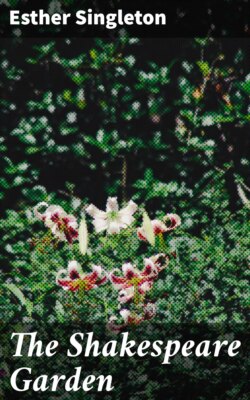Читать книгу The Shakespeare Garden - Singleton Esther - Страница 8
На сайте Литреса книга снята с продажи.
IV
Bagh-i-vafa
ОглавлениеTable of Contents
Babar's "Garden of Fidelity" was made in the year 1508. We see Babar personally superintending the laying out of the "four-field plot." Two gardeners hold the measuring line and the architect stands by with his plan. The square enclosure at the bottom of the garden (right) is the tank. The whole is bordered with orange and pomegranate trees. An embassy knocks at the gate, but Babar is too absorbed in his gardening to pay any attention to the guests.
Fifteen years later Babar stole three days away from his campaign against the Afghans and visited his beautiful garden. "Next morning," he wrote in his "Memoirs," "I reached Bagh-i-vafa. It was the season when the garden was in all its glory. Its grass-plots were all covered with clover; its pomegranate trees were entirely of a beautiful yellow color. It was then the pomegranate season and pomegranates were hanging red on the trees. The orange-trees were green and cheerful, loaded with innumerable oranges; but the best oranges were not yet ripe. I never was so much pleased with the 'Garden of Fidelity' as on this occasion."
BABAR'S "GARDEN OF FIDELITY"
Several new ideas were introduced into English gardens in the first quarter of the Sixteenth Century. About 1525 the geometrical beds called "knots" came into fashion, also rails for beds, also mounds, or "mounts," and also arbors. Cardinal Wolsey had all these novelties in his garden at Hampton Court Palace. It was a marvelous garden, as any one who will read Cavendish may see for himself; but Henry VIII was not satisfied with it when he seized the haughty Cardinal's home in 1529. So four years later the King had an entirely new garden made at Hampton Court (the Privy Garden is on the site now) with gravel paths, beds cut in the grass, and railed and raised mounds decorated with sun-dials. Over the rails roses clambered and bloomed and the center of each bed was adorned with a yew, juniper, or cypress-tree. Along the walls fruit-trees were planted—apples, pears, and damsons—and beneath them blossomed violets, primroses, sweet williams, gilliflowers, and other old favorites.
Toward the end of his reign Henry VIII turned his attention to beautifying the grounds of Nonsuch Palace near Ewell in Surrey. These gardens were worthy of the magnificent buildings. A contemporary wrote: "The Palace itself is so encompassed with parks full of deer, delicious gardens, groves ornamented with trellis-work, cabinets of verdure and walks so embowered with trees that it seems to be a place pitched upon by Pleasure herself to dwell in along with health."
